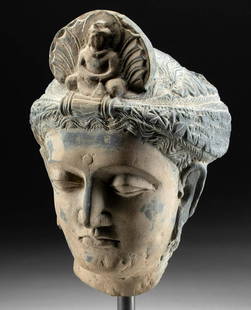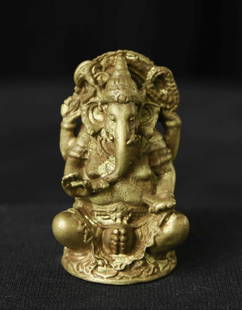
Gandharan Stucco Head of Buddha / Prince Gautama
Similar Sale History
View More Items in Sculptures & CarvingsRelated Sculptures & Carvings
More Items in Indian Sculptures & Carvings
View MoreRecommended Art
View More




Item Details
Description
Central Asia, Pakistan and Afghanistan, Gandharan Empire, ca. 200 BCE to 300 CE. An elegant stucco bust of Buddha as a young man, perhaps as Prince Gautama, modeled in the traditional Greco-Buddhist tradition with a full face, fine almond eyes that are uniquely pointed at the midlines, arched brows that lead to a naturalistic nose, and full, closed lips, with a wavy coiffure adorned by a headband. The eyes which appear to protrude from the face, almost like seashells, are most striking and may indicate that the Buddha/Prince is closing them tightly as if engaged in deep meditation. Size: 5.75" L x 5.75" W x 7.375" H (14.6 cm x 14.6 cm x 18.7 cm); 9.875" H (25.1 cm) on included custom stand.
Gandharans are famous for schist and stucco carvings, with stucco replacing schist as the more dominant material by the 3rd century CE. Vast monastic institutions like those at Takht-i-Bahi, Sahri-Bahlol, Jamal Garhi, Ranigat, and Thareli were decorated by skilled artisans with stucco representations of important figures, religious scenes, and artistic dedications. Stucco allowed artists more freedom in portraying lifelike features. During this time, Gandhara was exceptionally wealthy, profiting from trade along the Silk Road; so patrons had resources to spend on the arts, creating a flowering of stucco artwork. Some monumental statues had stucco hands, feet, and heads alongside clay torsos - the size of these figures was such that clay was needed to maintain their form.
The ancient Gandhara civilization flourished in northeastern Afghanistan and northwestern Pakistan. Located along the Silk Route, the region was exposed to cultural influences of both the East and the West, from Greece to China. Gandhara thrived during the Kushan Dynasty under the direction of King Kanishka, who scholars posit was responsible for spreading Buddhism's philosophies throughout Central Asia and into China. Following Alexander the Great's conquests, Greek influence spread into Gandhara and sculptors' renderings of Buddha were inspired by Greco-Roman models, akin to a youthful Apollo, with similarly curly coiffures and flowing robes. Impressive Gandharan creations, such as this example, resulted from these links between East and West.
Provenance: ex-Barakat Gallery, Beverly Hills, California, USA, acquired prior to 2000
All items legal to buy/sell under U.S. Statute covering cultural patrimony Code 2600, CHAPTER 14, and are guaranteed to be as described or your money back.
A Certificate of Authenticity will accompany all winning bids.
We ship worldwide to most countries and handle all shipping in-house for your convenience.
#162128
Gandharans are famous for schist and stucco carvings, with stucco replacing schist as the more dominant material by the 3rd century CE. Vast monastic institutions like those at Takht-i-Bahi, Sahri-Bahlol, Jamal Garhi, Ranigat, and Thareli were decorated by skilled artisans with stucco representations of important figures, religious scenes, and artistic dedications. Stucco allowed artists more freedom in portraying lifelike features. During this time, Gandhara was exceptionally wealthy, profiting from trade along the Silk Road; so patrons had resources to spend on the arts, creating a flowering of stucco artwork. Some monumental statues had stucco hands, feet, and heads alongside clay torsos - the size of these figures was such that clay was needed to maintain their form.
The ancient Gandhara civilization flourished in northeastern Afghanistan and northwestern Pakistan. Located along the Silk Route, the region was exposed to cultural influences of both the East and the West, from Greece to China. Gandhara thrived during the Kushan Dynasty under the direction of King Kanishka, who scholars posit was responsible for spreading Buddhism's philosophies throughout Central Asia and into China. Following Alexander the Great's conquests, Greek influence spread into Gandhara and sculptors' renderings of Buddha were inspired by Greco-Roman models, akin to a youthful Apollo, with similarly curly coiffures and flowing robes. Impressive Gandharan creations, such as this example, resulted from these links between East and West.
Provenance: ex-Barakat Gallery, Beverly Hills, California, USA, acquired prior to 2000
All items legal to buy/sell under U.S. Statute covering cultural patrimony Code 2600, CHAPTER 14, and are guaranteed to be as described or your money back.
A Certificate of Authenticity will accompany all winning bids.
We ship worldwide to most countries and handle all shipping in-house for your convenience.
#162128
Condition
A fragment from a larger statue. Uncarved on verso suggesting it is a high relief. Chips/losses to pointed midlines of eyes, ears, nose, chin, cheeks, and high pointed areas of coiffure. Normal surface wear commensurate with age. Surface also graced with scattered deposits.
Buyer's Premium
- 24.5%
Gandharan Stucco Head of Buddha / Prince Gautama
Estimate $2,000 - $3,000
3 bidders are watching this item.
Shipping & Pickup Options
Item located in Louisville, CO, usOffers In-House Shipping
Local Pickup Available
Payment

TOP


































![Plaster Gautama Buddha Head Sculpture: DESCRIPTION: Plaster sculpture depicting the head of Gautama Buddha. Marked with "[copyright] MPI" at underside. Atop a wooden stand. CIRCA: 20th century ORIGIN: Unknown DIMENSIONS: (On stand) H: 16"](https://p1.liveauctioneers.com/1373/326919/176011116_1_x.jpg?height=310&quality=70&version=1713561897)









![Bluestone Martial God Hercules [Buddha Head]: This Buddha statue has a domineering face, fine carvings, clear eyebrows and wide-open eyes, bright and energetic, looking down at the world. Height 46cm Width 33cm weight 1kg Freight: 1.International](https://p1.liveauctioneers.com/8447/327029/176223712_1_x.jpg?height=310&quality=70&version=1713609591)

































